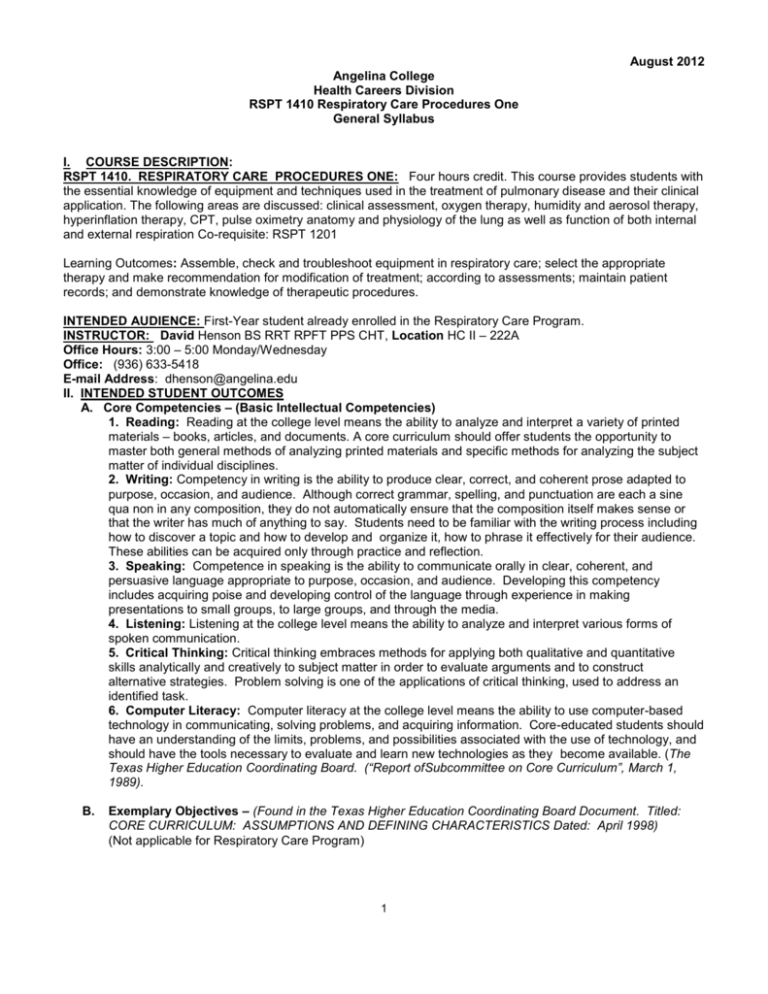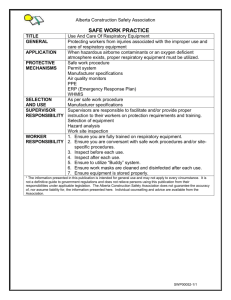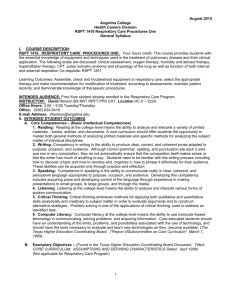Syllabus - Angelina College
advertisement

August 2012 Angelina College Health Careers Division RSPT 1410 Respiratory Care Procedures One General Syllabus I. COURSE DESCRIPTION: RSPT 1410. RESPIRATORY CARE PROCEDURES ONE: Four hours credit. This course provides students with the essential knowledge of equipment and techniques used in the treatment of pulmonary disease and their clinical application. The following areas are discussed: clinical assessment, oxygen therapy, humidity and aerosol therapy, hyperinflation therapy, CPT, pulse oximetry anatomy and physiology of the lung as well as function of both internal and external respiration Co-requisite: RSPT 1201 Learning Outcomes: Assemble, check and troubleshoot equipment in respiratory care; select the appropriate therapy and make recommendation for modification of treatment; according to assessments; maintain patient records; and demonstrate knowledge of therapeutic procedures. INTENDED AUDIENCE: First-Year student already enrolled in the Respiratory Care Program. INSTRUCTOR: David Henson BS RRT RPFT PPS CHT, Location HC II – 222A Office Hours: 3:00 – 5:00 Monday/Wednesday Office: (936) 633-5418 E-mail Address: dhenson@angelina.edu II. INTENDED STUDENT OUTCOMES A. Core Competencies – (Basic Intellectual Competencies) 1. Reading: Reading at the college level means the ability to analyze and interpret a variety of printed materials – books, articles, and documents. A core curriculum should offer students the opportunity to master both general methods of analyzing printed materials and specific methods for analyzing the subject matter of individual disciplines. 2. Writing: Competency in writing is the ability to produce clear, correct, and coherent prose adapted to purpose, occasion, and audience. Although correct grammar, spelling, and punctuation are each a sine qua non in any composition, they do not automatically ensure that the composition itself makes sense or that the writer has much of anything to say. Students need to be familiar with the writing process including how to discover a topic and how to develop and organize it, how to phrase it effectively for their audience. These abilities can be acquired only through practice and reflection. 3. Speaking: Competence in speaking is the ability to communicate orally in clear, coherent, and persuasive language appropriate to purpose, occasion, and audience. Developing this competency includes acquiring poise and developing control of the language through experience in making presentations to small groups, to large groups, and through the media. 4. Listening: Listening at the college level means the ability to analyze and interpret various forms of spoken communication. 5. Critical Thinking: Critical thinking embraces methods for applying both qualitative and quantitative skills analytically and creatively to subject matter in order to evaluate arguments and to construct alternative strategies. Problem solving is one of the applications of critical thinking, used to address an identified task. 6. Computer Literacy: Computer literacy at the college level means the ability to use computer-based technology in communicating, solving problems, and acquiring information. Core-educated students should have an understanding of the limits, problems, and possibilities associated with the use of technology, and should have the tools necessary to evaluate and learn new technologies as they become available. (The Texas Higher Education Coordinating Board. (“Report of Subcommittee on Core Curriculum”, March 1, 1989). B. Exemplary Objectives – (Found in the Texas Higher Education Coordinating Board Document. Titled: CORE CURRICULUM: ASSUMPTIONS AND DEFINING CHARACTERISTICS Dated: April 1998) (Not applicable for Respiratory Care Program) 1 C. Course Objectives – (common to all sections) 1. To introduce the student to the skills required for prevention and control of infection when treating Respiratory Therapy patients. 2. To promote proper understanding of assessment skills to properly identify certain diseases and conditions rapidly and direct therapy to alleviate symptoms. 3. To gain entry-level knowledge and psychomotor skills of oxygen related therapeutic modalities and equipment and the safe operation of same. 4. To introduce the student to the various methods of delivering humidity and aerosol therapy to meet therapeutic needs of respiratory care patients. 5. To promote a proper understanding of the goals and objectives of hyperinflation therapy. 6. To develop critical thinking skills in care of cardiopulmonary patients. D. Course Objectives - (not applicable to Respiratory Care) III. ASSESSMENT MEASURES OF STUDENT LEARNING OUTCOMES A. Assessments for the Core Intellectual Competencies – 1. Reading – Competency in reading will be assessed through the student’s reading and understanding of course materials and critical-thinking patient case study exercises. 2. Writing – Competency in writing will be assessed through written responses to the critical-thinking patient case studies 3. Speaking – Competency in speaking will be assessed through oral responses and participation on small and large group oral discussions of the critical thinking patient case studies. 4. Listening – Competency in listening will be assessed through the student’s verbal response to questions and following instructions for the large and small group critical thinking activities 5. Critical Thinking – Competency in critical thinking will be demonstrated through their participation in critical-thinking patient case studies which involves both oral discussion and written activities. 6. Computer Literacy – Competency in computer literacy will be assessed through in computer clinical simulations and required internet research assignments. B. Assessments for the Exemplary Objectives Specific to the Course – (Not Applicable for the Respiratory Care Program) C. Assessments for Objectives Specific to the Course – CORE COMPETENCIES: SCANS – (Secretary’s Commission on Academic Necessary Skills) Students are expected to demonstrate basic competency in academic and workforce skills. The following are competencies with evaluation are included in RSPT 1410. SCAN Skills Assessments Foundation Skills Written Assignments Oral Presentations Required Readings Critical Thinking Case Studies Demonstrated Competency in Clinical Workplace Competencies Computer Assisted Instruction Critical Thinking Case Study Assessments Demonstrated Competency in Clinical D. Assessments for the Objectives of the Course as determined by the Instructor – Non-applicable IV. INSTRUCTIONAL PROCEDURES – The methods of instruction used in this course includes but not limited to the following: Lecture, lab, discussion, performance, audiovisual, computer assisted instruction and critical-thinking patient case studies. 2 V. COURSE REQUIREMENTS AND POLICIES – A. Required Textbooks, Materials and Equipment – Kacmarek Robert M (2013) Egan's Fundamentals of Respiratory Care (10th Ed), Elsevier Kacmarek Robert M (2013) Egan’s Fundamentals of Respiratory Care Workbook (10th Ed), Elsevier Cairo, J. M., (2014) Mosby’s Respiratory Care Equipment (9th Ed), Elsevier Cairo, J. M., (2014) Mosby’s Respiratory Care Equipment Workbook (9th Ed), Elsevier Equipment already purchased in the lab. The student must have a basic calculator for simple mathematical calculations. The calculator must be brought to each class. A medical dictionary would be helpful but not required. Cell phones must be turned off. There is to be no texting in class. The cell phone is not to be used as a calculator. See cell phone usage policy. B. Assignments – Class meets Monday and Wednesdays 1:30pm – 4:00pm August 27 Syllabus Review, Sept 1 - 3 Labor Day Unit I Egan Chapter 4 Sept 8 -10 Egan Chapter 4 Chapter 15 Sept 15 - 17 Egan Chapter 15 Sept 22 - 24 Egan Chapter 33 Sept 29 -Oct 1 Review Unit Test I Oct 6 - 8 Egan Chapter 37 Oct 13 - 15 Egan Chapter 38 Oct 20 - 22 Unit Test II Chapter 35 Oct 27 - 29 Egan Chap 35 -Chapter 36 Nov 3 - 5 Egan Chapter 36 Unit Test III Nov 10 - 12 Egan Chap 40 Egan Chapter 39 Nov 17 -19 IPPB - IPPB Ventilation Nov 24 - 26 Egan Chapter 20 Thanksgiving Holiday Dec 1 - 3 Review - Unit Test IV Dec 8 - 10 Entry Level Exam - Review Dec 15 - 17 Review and Final Exam Course Policies – (This course conforms to the policies of Angelina College as stated in the Angelina College Handbook and the Respiratory Care Program Handbook) Academic Assistance – If you have a disability (as cited in Section 504 of the Rehabilitation Act of 1973 or Title II of the Americans with Disabilities Act of 1990) that may affect your participation in this class, you should see Karen Bowser, Room 200 of the Student Center. At a post-secondary institution, you must selfidentify as a person with a disability; Ms. Bowser will assist you with the necessary information to do so. To report any complaints of discrimination related to disability, you should contact Dr. Patricia McKenzie, Administration Building, Room 105 or 936-633-5201. Attendance – This course will follow the guidelines as prescribed in the Angelina College Handbook. Additional Specific Requirements for this Course – When a student does not officially withdraw in the Office of Admissions, an F will appear on the transcript for the course (s) in progress at that time. All exams and written assignments become the property of the Angelina College Respiratory Care Program. 3 VI. COURSE CONTENT – A. Content/ Topics – Unit 1: Infection Control and Respiratory Assessment of patient After completion of this unit, the student will be able to: 1. 2. 3. 4. 5. 6. 7. 8. 9. 10. 11. 12. 13. 14. 15. 16. Define and explain How Infection Spreads. Describe the methods currently used to prevent infection Describe and explain the different methods and equipment and clothing use of protection. Describe why infection prevention is important in Respiratory Care Identify and explain the three elements that must be present for transmission of infection within a hospital. Describe strategies used to control the spread of infection in the hospital settings Describe strategies used to control the spread of infection in the home care setting Describe three major routes for transmission of human pathogens in a health care setting Describe the different methods of sterilizing equipment used in Respiratory Therapy Describe the difference between clean, disinfected and sterilization. Describe why patient interviews are necessary and important for conducting interviews Identify some breathing patterns associated with underlying pulmonary disease Describe how somatic and autonomic nervous systems connect and control the lungs. Differentiate between dyspenea and breathlessness. Identify terms used to describe normal and abnormal lung sounds. Define and demonstrate auscultation, palpitation and percussion of thorax Unit Two: Storage and deliver of medical gases and their therapeutic use After completion of this unit, the student will be able to: 1. 2. 3. 4. 5. 6. 7. 8. 9. 10. 11. 12. 13. 14. 15. 16. 17. 18. 19. Describe how medical gases and mixtures are produced. Assess the need for Oxygen. Describe the three major safety system used in medical gas distribution systems Describe characteristic of gaseous &liquid bulk oxygen storage and delivery systems discuss their importance. Describe and explain use of Bernoulli's principle in Respiratory Therapy Identify the markings stamped on a cylinder shoulder and their function Distinguish between liquid and gaseous storage system. Calculate the duration of remaining contents of both gaseous and liquid oxygen Describe how to store, transport and use compressed cylinders properly Describe what to do if a bulk liquid oxygen system fails Select the appropriate devices to regulate both pressure and flow for patient needs Describe how to check for proper function and identify and solve problems of oxygen delivery systems Describe how to evaluate and monitor a patient’s response to Oxygen therapy. Describe how to implement and oxygen therapy protocol. Describe indication, complications and hazards that apply to hyperbaric oxygen therapy Describe the indications and equipment used for Nitric Oxide and Helium/Oxygen Therapy. Describe what precautions and complication are associated with oxygen therapy. Explain what type of Oxygen delivery system is appropriate for each patient Differentiate the following supply systems; describe their construction and their principles of operation: cylinders, liquid reservoirs, piping systems, compressors and concentrators 20. Identify the contents of a medical gas cylinder using the U.S. ad International color code system for the following gases: oxygen, carbon dioxide, nitrous oxide, helium, carbon dioxide and oxygen (carbogen) helium and oxygen (heliox) and air. 21. Given several critical thinking patient case studies and or lab simulations, select, assemble, use, and ascertain effective use of all oxygen delivery devices. 4 Unit 3: Humidity, Aerosol and Lung Expansion Therapy: After completion of this unit, the student will be able to: 1. 2. 3. 4. 5. 6. 7. 8. 9. 10. 11. 12. 13. 14. 15. 16. 17. Define the terms humidity, both relative and absolute and aerosols. Identify the factors that affect the performance of humidification devices. Discuss the aerosol particle sizes and their place of deposition. Discuss the terms isotonic, hypertonic and hypotonic solutions Describe the ideal ventilatory pattern that should be used during aerosol therapy. Differentiate the 3 major goals of aerosol therapy. Identify the major hazards associated with the delivery of therapeutic aerosols to the respiratory tract and ways to minimize these risks. Explain the relationship of temperature to the capacity of a gas to hold water. Explain 3 ways a humidifier can be designed to increase its efficiency Explain the principle of operation for the following types of humidifiers: pass-over bubble/bubble jet wick diffusion grid, membranes Heat Moisture Exchangers Explain the principle of operation for both small and large volume nebulizers, their assembly, and clinical application and how to troubleshoot them. Explain the functional characteristics and application of the following aerosol delivery devices: Aerosol Mask, Trach Mask, Face Tent, Briggs Adapter, Drainage Bag Given several critical thinking patient case studies and or lab simulations, select, assemble, use, and troubleshoot all humidity and or aerosol therapy delivery devices. Describe the various causes of Atelectasis Using assessment skills identify which patient need lung expansion therapy Describe the clinical findings in atelectasis using assessment skills Describe the indications, hazards and complications associated with various modes of lung expansion therapy Unit 4: Respiratory Anatomy and Physiology After completion of this unit, the student will be able to: 1. Recognize normal airway anatomy 2. Describe proper placement of nasopharyngeal and oropharyngeal airways 3. Describe what patient assessment would indicate the need to place an artificial airway and which type 4. Describe the proper assessments performed to confirm correct placement of artificial airways 5. Explain how to insert a LMA and a Combi tube as well as suction catheters both regular and inline 6. Describe the proper sequence of steps to properly insert an endotracheal tube 7. Describe the care and maintenance of a tracheal tube 8. Describe methods to allow tracheal patients to talk while still using a tracheal tube 9. Describe ways to wean patients from artificial airways 10 Identify and discuss several different types of bag valve mask devices and their proper use and hazards 11. Identify the main functions of the thorax and describe their function 12. Identify and describe all muscles involved in respiration 13. Describe the pulmonary and bronchial circulation and how they function 14. Identify the parts of the upper airway and their function 15. Describe the different lobes of the lungs and the airways the connect them 16. Describe how and why the lungs produce mucus 17. Describe the anatomy of the heart and vascular systems 18. Describe vascular resistance; mean arterial pressure central venous pressure and cardiac output 19. Describe how the cardiovascular system works under normal and abnormal situations 20. Describe the electrical and mechanical events of the heart and how they work 21. Describe how carbon dioxide and oxygen move between the atmosphere and the cells 22. Calculate the alveolar partial pressure of oxygen at different barometric pressure and oxygen concentrations 23. Demonstrate how to calculate oxygen content of arterial and venous blood and it significance 24. Describe how oxygen and carbon dioxide and transported in the blood and its significance 5 B. Additional Content – (None) VII. EVALUATION AND GRADING A. Grading Criteria – 1. Lecture: Assignments/Quizzes Research Project Unit Examinations Final Examination 30% 10% 40% 20% 100% 2. Laboratory: Performance Evaluation (as needed). B. Determination of Grade – The alphabetic grading for this course is as follows: A = 92 - 100 B = 83 - 91 C = 75 - 82 D = 70 - 74 F = 69 & below VIII. SYLLABUS MODIFICATION – The instructor may modify the provisions of the syllabus to meet individual class needs by informing the class in advance as to the changes being made. 6





